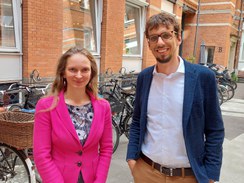What is the EEA's 'TERM report' all about?
Tommaso:
'TERM' stands for Transport and Environment Reporting Mechanism. It is an annual report of the EEA that looks broadly at the trends and challenges in Europe's mobility system. It also offers a yearly assessment of the transport sector, highlighting what is improving and the aspects where there is still work to do.
The TERM report is an important part of our work in supporting Europe’s environment and climate ambitions. So far, the mobility system has had only limited success in reducing emissions and shifting towards more sustainable transport modes. Timely and actionable knowledge, like what is presented in the TERM reports, is a key part of guiding the process towards sustainability.
What were the main findings of the most recent TERM report?
Rasa:
The expected shift towards electrification of transport will contribute to reducing emissions.
Rasa Narkeviciute
The 2021 TERM report starts with the issue that transport is responsible for about a quarter of the EU’s greenhouse gas emissions. Road transport represents the greatest share of these emissions, which have also increased by nearly 30% over the past 30 years.
With existing policy measures, transport emissions are projected to decrease, but not sufficiently for the sector to contribute enough to the 2050 climate neutrality target.
Emissions from cars and from heavy goods vehicles, trucks, have grown mainly due to increasing transport demand. The vehicles themselves have become more efficient, emitting less for each kilometre they travel, but not enough to make up for the increasing activity.
What needs to happen to change the trend of increasing emissions?
Rasa:
The expected shift towards electrification of transport will contribute to reducing emissions. But this also means that power generation and its efficiency will become increasingly important. It is important that the emissions are not simply transferred from the road to a power station in another location but that we make the necessary investments in renewables.
To contribute to wider sustainability of transport, electrification will need to be coupled with changes in the way we organise our mobility system. A shift to more sustainable modes is needed as well as ensuring that not only transport activity, but also the accessibility of jobs and services is in focus. For this, broad policies are needed. For example, city planning can ensure sufficient space for cycling infrastructure while also locating services, commercial activity, and residential areas closer to each other.
What are the EU and Member States doing to address these challenges?
Rasa:
The European Parliament recently backed the proposed objective to achieve zero emissions from new cars and vans by 2035. If Member States also agree, this will mean a major decrease in emissions generated on the European roads over the coming decades.
The Sustainable and Smart Mobility Strategy also contains objectives related to the shift to more sustainable transport modes. This includes targets for increasing high-speed rail, rail freight traffic and shipping by waterways.
What other work the EEA is doing around transport?
Rasa:
The EEA collects large amounts of data related to vehicles and fuels from European countries and from vehicle manufacturers. This includes data on new cars, vans, trucks, buses and trailers registered in the EU, which allow us to evaluate the efficiency of the new vehicle fleet. We also collect data about fuels used in Europe's road transport and mobile machinery. This includes the type and quantity of fuels used as well as the emissions associated with extracting, processing and distributing those fuels. For biofuels, we also look at the effects of indirect land-use change.
We analyse these data to track progress towards policy targets through regular indicator assessments that we share publicly on our website. In addition to using our own data, we also prepare policy relevant indicators based on wider EEA or external data, for example, greenhouse gas emissions from transport, and, later this year, the share of buses and trains in all transport.
Tommaso:
The EEA is also working in other areas of the mobility system and transport. Some of the additional activities going on at the moment are in the maritime and aviation sectors, where we prepare new editions of sector specific reports, in collaboration with our partners in other EU agencies.
These are the European Maritime Transport Environmental Report in collaboration with the European Maritime Safety Agency and the European Aviation Environmental Report in collaboration with the European Union Aviation Safety Agency and Eurocontrol (European Organisation for the Safety of Air Navigation).
What is the theme of the next TERM report by EEA?
Tommaso:
Right now, we are working on the next edition of the TERM report with the aim to publish it later this year. It will be on the broad topic of digitalisation in the mobility system and will explore many innovations enabled by digital technologies and how these might impact the sector, the environment and our lives.

Rasa Narkeviciute and Tommaso Selleri, EEA experts on transport and environment

Document Actions
Share with others